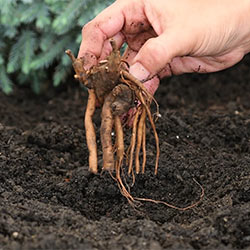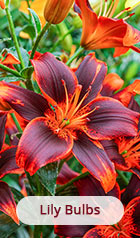
Hostas
Hostas are a versatile perennial plant capable of thriving in shaded areas and damp, rich
gardens. Hostas are known for their often large, tropical-appearing leaves, and tall scapes of small flowers. These plants are actually members of the asparagus family, and you'll see the resemblance in their tall flower scapes. Different varieties of hosta have leaves appearing in shades of blue, yellow, and green, and may also feature interesting ribbing or patterns.
Hosta are among the easiest plants to grow, in part due to their ability to thrive in polluted or urban environments. These plants grow in a wide variety of sizes, so you'll be sure to find a hosta plant perfect for your landscape. Learn more about how to care for your hosta plants below!
Hosta Plant Quick Facts
Botanical Name
Hosta
Most Popular Varieties of Hosta
There are so many hostas to choose from, where should you begin? Common hosta plant colors include green, white, yellow, or blue foliage, and many hosta have white or purple flowers. There's also a wide variety of shape and size among hosta cultivars-you could truly build an entire garden out of hosta alone. Let's look at some of our favorite types of hosta.
Tardiana hostas

Plants described as members of the Tardiana group are generally large-leaved cultivars with blue-green leaves. The blue-green color is absolutely striking, and these plants generally have a very pleasant, mounded shape.
Colossal Blue Hosta is an excellent example of this group.
Giant hostas

Giant hosta have an impressive footprint, thanks to their extra large leaves. Plants like
Empress Wu can grow up to 4 feet tall and six feet wide, with leaves well over thirty inches. If you're looking for huge, leafy impact, consider giant hosta!
Yellow hostas

Yellow hosta stand out beautifully on rainy days, and many varieties have contrasting color on the flowers or stems.
Lipstick Blonde hosta features red stems and nodding, lavender flowers.
Curly hostas

Curly-edged hostas, like our favorite
Silly String Hosta, add something completely unique to the garden, with interesting texture and wild, funky shapes.
Smaller hostas

Not all hostas are gigantic. Smaller varieties like
June Hosta and
Blue Mouse Ears feature the elegant, heart-shaped leaves of the hosta family with a compact and tidy habit. Both of these hostas are perfect for containers!
Blooming Season
While hostas are all about the foliage, these plants do grow attractive flowers, and some species can have flowers that are quite large. Hostas will typically bloom in mid-summer, with scapes sprouting from the plants a few weeks before blooming. Some hostas have very long bloom times, and the foliage remains intact from spring far into autumn.
Soil Preferences
Hosta plants prefer well-drained soil rich in nutrients. While they don't appreciate soggy soil, they will thrive particularly well in soil that is consistently watered. Before planting, add compost to your soil for additional richness and to assist in drainage. Hostas cannot be planted underwater-they will thrive near water features, but not inside of them.
Climate Preferences
Hostas are able to thrive in nearly any climate-cold, hot, even in places with pollution, such as city streetscapes. Hostas are considered to be winter-hardy in most temperate climates, but cannot tolerate winters with far below-freezing temperatures in Zones 1 and 2. Hostas really appreciate humidity, especially during the growing season, so the best growing conditions for your hosta plant would be an area with high moisture. You can also water your hosta consistently to keep the moisture level in the right range.
Sun Exposure
Plant your hosta in an area with shade or filtered light. Hostas grow best in morning sun and afternoon shade. Generally, blue-leaved hostas require shadier conditions, to keep their color, than gold- and white-leaved varieties, and green-leaved hostas are the most sun-tolerant.
Hosta Plant Care
Hosta plants are a great choice for a carefree perennial with beautiful foliage. They can thrive in both shade and partial sun, they can handle a variety of soil and climate types, and, of course, they're grown in a large variety of shapes, colors, and sizes. To help you get started growing hostas, we've included some hosta care tips below:
-
All hostas prefer organic-rich soil, so add loam or compost to the soil before planting.
-
Consider the mature height and size of your hosta when planting. These plants tend to reach their maximum size relatively quickly, and grow so vigorously that they will knock out neighboring plants if not given appropriate spade.
-
Plant hostas near shorter shade plants for lots of interest in your shade garden.
-
After flowering, your hostas will still look beautiful in the garden. You can remove spent flower stems and scapes, or leave the scapes through the winter to add wintertime interest.
-
It's important to note that hostas are toxic to dogs, cats, and horses, so keep them away from any animals.
For a beginning gardener, there's nearly no better plant than a lush and luscious hosta. Be sure to check out our
tips for foolproof gardening page for more information on achieving success in your garden!
Hosta Plants Pests and Disease Prevention
In general, hostas are low-maintenance plants that suffer from few issues. However, it is important to be aware of problems with your hosta plant when they arise and know how to remedy them. Read on for some of the common issues and fixes for problems with hostas.
Slugs and Snails
These small bugs can cause damage to your hosta plants, eating tiny holes in the leaves of hostas, typically at night time. Luckily, these problems can be solved by setting traps. As unusual as it may sound, these bugs are attracted to beer, which will coax them away from your hosta plant.
Nematodes
Hostas can become a host for nematodes or small roundworms. These pests will thrive in moist soil and make their way to the leaves of the hosta plant. Once you have identified the problem, be sure to take measures to improve the health of your hostas by immediately removing any affected plants. One way to prevent nematodes is to ensure that your hosta plants are properly spaced apart when planting. Additionally, using soaker hoses to avoid wet foliage can be a good preventative measure.
Anthracnose
Anthracnose is a common fungal disease that typically affects hosta plants during periods of warm weather. Signs of anthracnose include large spots that are irregular in size and dark in color. Similar to nematode prevention, it is important to properly space out your hosta plants to reduce the risk of this disease. To treat hostas with anthracnose, use a fungicide spray.
Have another question? Return to the Customer Service Help page or send an e-mail directly to Customer Service



























